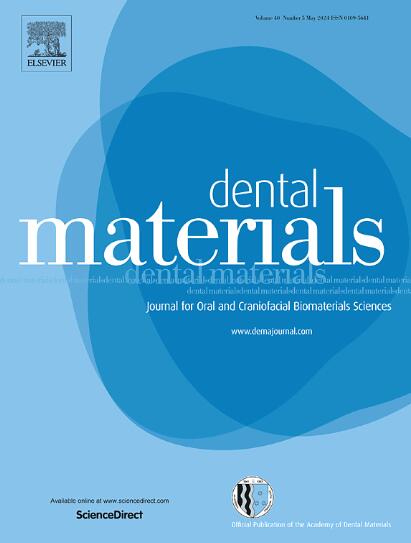通过加入四角形氧化锌开发抗菌双固化牙科树脂复合材料。
IF 4.6
1区 医学
Q1 DENTISTRY, ORAL SURGERY & MEDICINE
引用次数: 0
摘要
研究目的本研究旨在评估加入 0-20 wt% 的四足形氧化锌(tZnO)晶须对实验性双固化树脂复合材料的机械、抗菌和细胞毒性性能的影响:方法:使用 3-甲基丙烯酰氧基丙基三甲氧基硅烷(γ-MPS)对从市场上获得的 tZnO 晶须进行表面改性。随后,制作了四组含有 0、5、10 和 20 wt%硅烷化 tZnO 以及硼硅酸钡玻璃 (BaBSG) 填充物的树脂复合材料,同时保持填充物的总负载量为 60 wt%。利用根据 ISO 4049:2019 准则(如适用)制作的试样对机械性能进行了检测。固化深度立即进行量化,而三点弯曲强度、弯曲模量、断裂韧性、维氏硬度、抗压强度和直径拉伸强度则在 37 °C 蒸馏水中储存 24 小时后进行评估。培养变异链球菌(S. mutans)的浮游细菌,并使用磁盘扩散和微生物抗粘附试验检测其抗菌活性。在细胞培养基中制备标本提取物,并将人类脱落牙齿(SHED)的干细胞暴露于这些提取物的系列稀释液中,然后使用 CCK-8 检测法和活/死染色法评估细胞活力和存活率,从而检测细胞毒性:提高 tZnO 负载会显著降低固化深度、抗压强度(从 296.4 兆帕降至 254.6 兆帕)和直径拉伸强度(从 42.7 兆帕降至 31.0 兆帕),而弯曲强度(91.3-94.1 兆帕)、弯曲模量(6.4-6.6 GPa)、断裂韧性(0.96-1.04 兆帕-m0.5)和维氏硬度(36.5-37.4 kgf-mm-2)则保持不变。根据抗粘附测试和活体/死体染色,含有 tZnO 的复合材料对突变酵母菌的抗菌活性明显增强。用含有高达 20 wt% tZnO 晶须的树脂复合材料提取物处理 SHED,未观察到细胞毒性:本研究表明,用含量高达 20 wt% 的硅烷化 tZnO 来代替传统的玻璃钡粒子,可显著增强双固化树脂复合材料对突变菌的抗菌功能,而不会影响其机械性能。本文章由计算机程序翻译,如有差异,请以英文原文为准。
Development of antibacterial dual-cure dental resin composites via tetrapod-shaped zinc oxide incorporation
Objectives
This study aimed to evaluate the effects of incorporating the 0–20 wt% tetrapod-shaped zinc oxide (tZnO) whiskers on the mechanical, antibacterial, and cytotoxic properties exhibited by experimental dual-cure resin composites.
Methods
Commercially obtained tZnO whiskers underwent surface modification using 3-methacryloxypropyltrimethoxysilane (γ-MPS). Subsequently, four groups of resin composites containing 0, 5, 10, and 20 wt% silanized tZnO along with barium borosilicate glass (BaBSG) fillers were fabricated while maintaining total filler loading at 60 wt%. Mechanical properties were examined utilizing specimens produced adhering to ISO 4049:2019 guidelines where applicable. Depth of cure was quantified immediately, while three-point flexural strength, flexural modulus, fracture toughness, Vickers hardness, compressive strength, and diametral tensile strength were assessed after 24 h of storage in 37 °C distilled water. Planktonic bacteria of Streptococcus mutans (S. mutans) were cultured and tested for antibacterial activity using disk diffusion and microbial anti-adhesion assays. Cytotoxicity was examined by preparing extracts from specimens in a cell culture medium and exposing stem cells from human exfoliated deciduous teeth (SHED) to serial dilutions of these extracts, then assessing cell viability and survival using CCK-8 assay and live/dead staining.
Results
Elevating tZnO loading yielded significant reductions in depth of cure, compressive (from 296.4 to 254.6 MPa), and diametral tensile strength (from 42.7 to 31.0 MPa), while flexural strength (91.3–94.1 MPa), flexural modulus (6.4–6.6 GPa), fracture toughness (0.96–1.04 MPa·m0.5), and Vickers hardness (36.5–37.4 kgf·mm−2) remained the same. Composites integrating tZnO displayed markedly enhanced antibacterial activity against S. mutans, based on anti-adhesion tests and live/dead staining. No cytotoxicity was observed for SHED treated with extracts from resin composites possessing up to 20 wt% tZnO whiskers.
Significance
This study demonstrates that incorporating up to 20 wt% silanized tZnO in place of traditional barium glass particles appreciably enhances dual-cure resin composite antibacterial function against S. mutans without compromising mechanical properties.
求助全文
通过发布文献求助,成功后即可免费获取论文全文。
去求助
来源期刊

Dental Materials
工程技术-材料科学:生物材料
CiteScore
9.80
自引率
10.00%
发文量
290
审稿时长
67 days
期刊介绍:
Dental Materials publishes original research, review articles, and short communications.
Academy of Dental Materials members click here to register for free access to Dental Materials online.
The principal aim of Dental Materials is to promote rapid communication of scientific information between academia, industry, and the dental practitioner. Original Manuscripts on clinical and laboratory research of basic and applied character which focus on the properties or performance of dental materials or the reaction of host tissues to materials are given priority publication. Other acceptable topics include application technology in clinical dentistry and dental laboratory technology.
Comprehensive reviews and editorial commentaries on pertinent subjects will be considered.
 求助内容:
求助内容: 应助结果提醒方式:
应助结果提醒方式:


